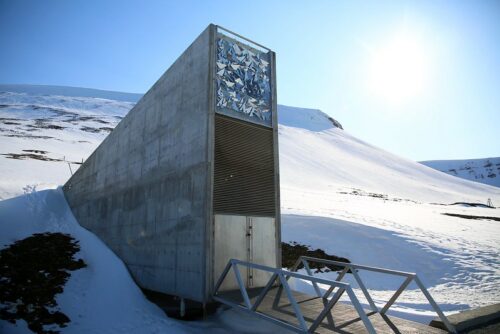Image courtesy of Flickr.
Every day, our dining halls are filled with countless choices: dozens of types of pizza, chicken tikka masala and aloo gobi, Cajun fish tacos, and cheese quesadillas. But if we take these foods back to their base ingredients, that variety vanishes. In fact, only three plants—rice, wheat, and maize—account for half of all calories consumed globally. This expanse of diverse food options masks a dramatic loss in true food biodiversity and the increased homogenization of agriculture and food production.
In his book Eating to Extinction: The World’s Rarest Foods and Why We Need to Save Them, Dan Saladino discusses the uniformity of modern food production, driven by a steep demand for low-cost, high-quantity food species. For example, half of the world’s cheese is made from bacteria and enzymes produced by the same company. The same breed of pig controls the international pork trade. And only one of the 1500 types of bananas dominates the global market. Saladino attributes this trend—sacrificing variety for surfeit—to a few concurrent factors: shifts in land usage, the introduction of chemical fertilizers and pesticides, and a rise in genetic modifications for crops and livestock alike. Dubbed the “Green Revolution,” this shift in the 1960s and 1970s was marked by unparalleled crop prosperity and food production, enough to sustain the world’s growing population. Overall yields of staple crops skyrocketed, but other wild crops were driven to near extinction.
While there may be more food produced overall, this marks a dangerous trend. A decline in food biodiversity increases the risk of pests and diseases disrupting global food security. For example, one fungus, Fusarium graminearum, has led to billions of dollars of damage by infecting wheat crops in Europe, Asia, and the Americas. Saladino runs through countless examples of mass-produced foods overshadowing traditional species, from Cosmic Crisp and Red Delicious apples overpowering the apple market to slaughterhouse chickens, eliminating the need for traditional breeds or historically used but now obsolete species. A loss of diversity comes with a loss of culture, identity, and history.
It is not too late to reverse the trend, however. From scientific seed repositories in Norway to government-run food conservation efforts, thousands of different crops, animals, and fruits have been painstakingly preserved in hopes of future reintroduction and production. Thankfully, corporations also have recognized the need for increased food biodiversity, and twenty of the world’s biggest food businesses have pledged to preserve traditional foods.
But the real hope is in the hands of farmers daring to continue their tradition, even in the face of agricultural giants. A “chocolate lab” in Venezuela specializes in producing traditional chocolate made from Criollo cacao. A village of resilient fishermen holds steadfast to their roots of selling wild Atlantic salmon. A group of millers on the Orkney Islands work with agronomists to bring back nutritious Bere barley. Even on the individual level, every effort is the chance to bring another species back from the brink of extinction. With a stroke of encouragement and support, the opportunity to restore food biodiversity is within reach.

